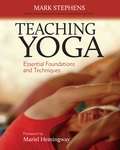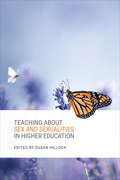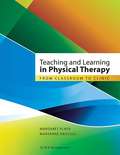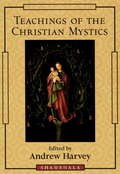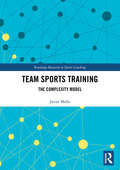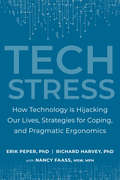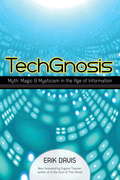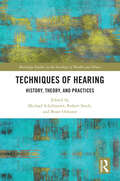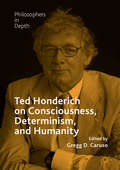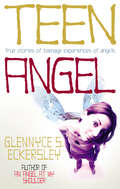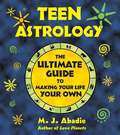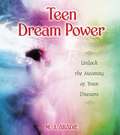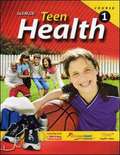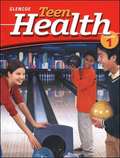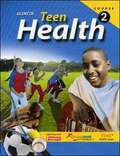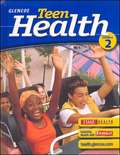- Table View
- List View
Teaching Yoga with Intention: The Essential Guide to Skillful Hands-On Assists and Verbal Communication
by Judith Hanson LasaterThe definitive guide to effective and appropriate communication through words and touch between yoga teachers and their students.Clear, effective verbal communication and judicious touch are two skills that Judith Hanson Lasater feels are essential for every yoga teacher. In Teaching Yoga with Intention, she gives pointed advice on how to interact verbally with students in class and how to appropriately use touch to make corrections. Drawing from her fifty years of yoga experience and her training in Nonviolent Communication, Lasater trains yoga teachers to effectively communicate not only technique, but also the more subtle lessons of respect, empathy, and compassion. She also shines an unflinching light on the use of touch in yoga. Teachers often use touch to create understanding and awareness in the poses. But this is a subtle art, and Lasater gives clear guidance on how, where, and when the use of touch can be used appropriately to further a student's development.In this book, Lasater also empowers students by encouraging them to take ownership of and responsibility for their practice. She covers myriad topics that can be difficult for students at any level to navigate, such as how and when to say "no" to an adjustment; keeping boundaries; when to leave a class; helping your teacher understand your needs; how to communicate your appreciation to your yoga teacher; and if and when to report a teacher's behavior. The skills that Lasater offers help create a safe environment for students to "own" their learning process, and to progress technically at their own speed.
Teaching Yoga, Second Edition: A Comprehensive Guide for Yoga Teachers and Trainers: A Yoga Alliance-Aligned Manual of Asanas, Breathing Techniques, Yogic Foundations, and More
by Mark StephensThe bestselling guide for yoga teachers and trainers, revised and updated—a comprehensive Yoga Alliance-aligned manual of asanas, breathing techniques, yogic foundations, and more.Revised and updated, Teaching Yoga by yoga expert Mark Stephens is one of the most popular resources for new and experienced teachers, and has been a trusted guide since its publication in 2010.This classic resource covers fundamental topics of yoga history and philosophy, as well as each of the 11 major styles of contemporary yoga. There is also practical advice for every stage of the teaching process, including tools for teaching 108 yoga poses (asanas), breathing techniques (pranayama), and meditation.The 2nd edition—adapted to meet the needs of the modern yoga teacher—features:Updated sections on yoga history and philosophyDiscussions of trauma-sensitive yogaCoverage of cultural appropriation, racism, and sexism in yoga An inclusive approach that expands beyond the traditional vinyasa flow styleNew photos and illustrations1-page summaries after each chapterAn extended list of references for further learningDeveloped to meet 100% of the teacher training curriculum standards set by Yoga Alliance, the world&’s leading registry and accreditation source for yoga teachers and schools, Teaching Yoga is ideal for use as a core textbook in yoga teacher training programs.
Teaching Yoga: Essential Foundations and Techniques
by Mariel Hemingway Mark StephensTeaching Yoga is an essential resource for new and experienced teachers as well as a guide for all yoga students interested in refining their skills and knowledge. Addressing 100% of the teacher training curriculum standards set by Yoga Alliance, the world's leading registry and accreditation source for yoga teachers and schools, Teaching Yoga is also ideal for use as a core textbook in yoga teacher training programs. Drawing on a wide spectrum of perspectives, and featuring more than 150 photographs and illustrations, the book covers fundamental topics of yoga philosophy and history, including a historical presentation of classical yoga literature: the Vedas, Upanishads, Bhagavad Gita, Yoga Sutras of Pataljali, and the main historical sources on tantra and early hatha yoga. Each of the eleven major styles of contemporary yoga is described, with a brief history of its development and the distinguishing elements of its teachings. Exploring traditional and modern aspects of anatomy and physiology, the book provides extensive support and tools for teaching 108 yoga poses (asanas), breathing techniques (pranayama), and meditation. Teaching Yoga offers practical advice for classroom setup, planning and sequencing classes, as well as the process involved in becoming a teacher and sustaining oneself in the profession. The book has over 200 bibliographic sources, a comprehensive index, and a useful appendix that lists associations, institutes, organizations, and professional resources for yoga teachers.From the Trade Paperback edition.
Teaching about Sex and Sexualities in Higher Education
by Susan HillockTeaching about Sex and Sexualities in Higher Education argues that much more can be done in teaching about sex and sexuality in higher education. This edited collection provides key information on professional training and support, and acts as a crucial resource on sex, sexuality, and related issues. With a focus on diversity, this book features expert contributors who discuss key concepts, debates, and current issues across disciplines to help educators improve curriculum content. This collection aims to provide adequate and appropriate sex education training and opportunities to educators so that they may explore complex personal and emotional issues, build skills, and develop the confidence necessary to help others in their respective fields.
Teaching and Learning in Physical Therapy: From Classroom to Clinic
by Maryanne Driscoll Margaret M. PlackTeaching and learning are skills, and like other physical therapy skills, they must be learned and perfected. Teaching and Learning in Physical Therapy: From Classroom to Clinic offers a systematic approach to designing, implementing, and evaluating effective teaching-learning experiences. Each chapter begins with Objectives that clearly delineate what you will be prepared to do after completing the chapter and concludes with a Summary of the major concepts presented. Stop and Reflect sections allow you to actively engage with the content as you process the information and move through the chapters. Critical Thinking Clinical Scenarios provide multiple opportunities for you to apply and adapt key concepts to real world situations. Finally, concepts are reinforced through frequent Key Points to Remember sections. Drs. Margaret Plack and Maryanne Driscoll have over 35 years of experience in teaching, research, and clinical practice. Teaching and Learning in Physical Therapy is grounded in current literature and has a theoretical basis in reflective practice, active learning strategies, and brain compatible instruction. Also included in this text are practical strategies that allow students, educators, and clinicians, working with both students and patients, to enhance their critical thinking and clinical decision-making processes in a variety of settings and situations.
Teaching the World to Sleep: Psychological and Behavioural Assessment and Treatment Strategies for People with Sleeping Problems and Insomnia
by David R. LeeTeaching the World to Sleep provides a complete, science-based overview of sleep and sleep problems, from environmental, legal, and technological factors to assessment and treatment options. David R. Lee introduces the basic scientific concepts involved in sleep and provides a clear description of insomnias and the parasomnias. Teaching the World to Sleep discusses NICE-recommended Cognitive Behavioural Therapy for Insomnia (CBT-i) and the REST programme® and outlines considerations for at-risk groups, sleep and the law, and the application of dreams and dreaming in psychotherapy. This second edition includes a full update on research conducted since the publication of the first edition and includes new information on sleep in the legal setting, the rise of sleep apps and trackers and their impact on our sleep. Lee also considers neurodiversity, sleep in long Covid, rare and unusual sleep disorders and the delivery of treatment using the NHS-recommended stepped-care approach. Teaching the World to Sleep will be essential reading for psychotherapists, occupational therapists, and other professionals working with clients with sleep problems. It will also provide an accessible introduction to the science of sleep to readers looking to understand their own sleep problems.
Teachings of Tibetan Yoga: An Introduction to the Spiritual, Mental, and Physical Exercises of the Tibetan Religion [Illustrated Edition]
by Garma C. C. ChangThe author-translator of this book was born in China of aristocratic parentage some fifty years ago. In early youth he became the disciple of a Buddhist Guru in a part of China near Tibet. His Guru sent him to Tibet to further his training. After eight years in Tibetan monasteries, six of them under one Guru, he went to school in the West to study animal husbandry and bring his knowledge hack to Tibet. The Communist victory in China and the Communist invasion of Tibet cut him off from returning. His devotion to Tibetan Buddhism is now expressed by translating into English its hitherto unknown teachings.This Book is an extremely concentrated introduction to the mental, physical, and spiritual exercises of Tibetan Buddhism, emphasizing the practice of Yoga exercises. The key to its understanding is the learning of Dumo--the generating of internal heat in one's body.Dumo's special meaning for Tibetan Yoga flows from the profoundly anti-ascetic and anti-pessimistic doctrine of Tantric Buddhism. The author means precisely what he says when he explains that opposites are also inseparable unities and that the best example of this is that the human body-mind can be made into the body of Buddha. Sexual bliss can become divine bliss.This work will both introduce the reader to the tranquility of yoga and, at the same time, lead him to explorations in the field of erotic mysticism.Richly illustrated throughout.
Teachings of the Christian Mystics
by Andrew HarveyThe Christian mystics are the treasure of Western civilization--yet they remain little known among those of us who are potentially their spiritual heirs. Andrew Harvey's anthology confronts us with the mystics in their own words, to show us how well they serve, even now, as guides for the spiritual life--and to challenge our preconceived ideas about the path of Christianity. He has chosen selections that represent all eras of the Christian tradition, as well as the amazing range of people who have embodied it, people like Francis of Assisi, Meister Eckhart, Julian of Norwich, Teresa of Avila, Thomas Merton, Bede Griffiths, and many others.
Teachings of the Peyote Shamans: The Five Points of Attention
by José Stevens James EndredyA rare in-depth look at the inner workings of Huichol shamanism • Describes the five sacred sites of the Huichol and their peyote ceremonies • Explains how the Huichol teachings of awareness, centered on the five points of attention, connect you to your true essence • Reveals the deep relationship between Huichol cosmology, Gnosticism, and Christianity, especially Jesus Christ and the Virgin Mary Taking place in the heart of the Huichol homeland in western Mexico, this book offers a rare in-depth look at the inner workings of Huichol shamanism, which is permeated with the use of the sacred peyote cactus. Outsiders are almost never allowed access to Huichol sacred sites and ceremonies; however, James Endredy, after years of friendship with Huichol families, earned the privilege nearly by accident. Swayed by persistent pleading, he agreed to take another gringo into the mountains to one of the Huichols’ ceremonial centers, and they were both caught. After trial and punishment, Endredy was invited to stay within the sacred lands for the festivities he had illegally intruded upon and found his initiation into the Huichol shamanic tradition had begun. Sharing his intimate conversations and journeys with the shaman he calls “Peyote Jesus,” the author explains how Huichol belief revolves around the five sacred directions, the five sacred sites, and the five points of attention. As Peyote Jesus explains, the five points of attention refer to dividing your awareness yet staying focused on your inner self. This is not a normal state of consciousness for most people, yet when we maintain these points of attention, we discover our true essence and move closer to God. Endredy undergoes dozens of spiritual journeys with peyote as he makes the pilgrimages to the five sacred Huichol sites with Peyote Jesus. He is shocked by his vision of the Virgin Mary while under peyote’s guidance and learns of the deep relationship--strictly on Huichol terms--between their cosmology, Gnosticism, and Christianity, especially Jesus Christ. Providing an inside look at the major ceremonies and peyote rituals of the Huichol, this unexpectedly powerful book reveals the key tenants of the Huichol worldview, their beliefs in the afterlife, and their spiritual work on behalf of all of humanity.
Team Sports Training: The Complexity Model (Routledge Research in Sports Coaching #10)
by Javier MalloTeam Sports Training: The Complexity Model presents a novel approach to team sports training, examining football (soccer), rugby, field hockey, basketball, handball and futsal through the paradigm of complexity. Under a traditional prism, these sports have been analyzed using a deterministic perspective, where the constituent dimensions of the sportsmen were independently examined and treated in isolation. It was expected that the body worked as a perfect machine and, once all the components were maximized, the sportsmen improved their performance. If the same closed recipe was applied to all the players that formed part of the squad, the global team performance was expected to be enhanced. As much as these reductionistic models seem coherent, when contrasted in practice we see that the reality of team sports is far more different from the closed conditions in which they were idealized. Team sports contain variable, heterogeneous and non-linear constrains which require the development of a different logic to organize their training. During the last years, ecological psychology, the dynamical systems theory or the constraints-led approach have opened interesting fields of research from which many conceptual foundations can be applied to team sports. Based in this contemporary framework, the current book presents the study of the players and the teams as complex systems, using coordination dynamics to explain the emergence of the self-organisation episodes that characterize them. In addition, this thinking line provides the reader with the ability to apply all these innovative concepts to their practical training scenarios. Altogether, it is intended to challenge the reader to re-think their training strategy and to develop an original theory and practice of training specific to team sports.
Team Sports Training: The Complexity Model (Routledge Research in Sports Coaching #10)
by Javier MalloTeam Sports Training: The Complexity Model presents a novel approach to team sports training, examining football (soccer), rugby, field hockey, basketball, handball and futsal through the paradigm of complexity. Under a traditional prism, these sports have been analyzed using a deterministic perspective, where the constituent dimensions of the sportsmen were independently examined and treated in isolation. It was expected that the body worked as a perfect machine and, once all the components were maximized, the sportsmen improved their performance. If the same closed recipe was applied to all the players that formed part of the squad, the global team performance was expected to be enhanced.As much as these reductionistic models seem coherent, when contrasted in practice we see that the reality of team sports is far more different from the closed conditions in which they were idealized. Team sports contain variable, heterogeneous and non-linear constrains which require the development of a different logic to organize their training.During the last years, ecological psychology, the dynamical systems theory or the constraints-led approach have opened interesting fields of research from which many conceptual foundations can be applied to team sports. Based in this contemporary framework, the current book presents the study of the players and the teams as complex systems, using coordination dynamics to explain the emergence of the self-organisation episodes that characterize them. In addition, this thinking line provides the reader with the ability to apply all these innovative concepts to their practical training scenarios. Altogether, it is intended to challenge the reader to re-think their training strategy and to develop an original theory and practice of training specific to team sports.
Tears Become Rain: Stories of Transformation and Healing Inspired by Thich Nhat Hanh
by John Bell Kaira Jewel Lingo Celia Landman32 mindfulness practitioners around the world reflect on encountering the extraordinary teachings of Zen master Thich Nhat Hanh, who passed away in January 2022, exploring themes of coming home to ourselves, healing from grief and loss, facing fear, and building community and belonging.Some moments change our lives. We experience wonder and relief when we realize we can be okay, just as we are. How do we then integrate these transformative moments into our daily life? Tears Become Rain is a collection of such stories, with one common inspiration: the teachings of mindfulness and compassion offered by the most influential meditation teacher of the past century, the Buddhist monk and peace activist Thich Nhat Hanh, who was nominated for the Nobel Peace Prize by Dr. Martin Luther King.The stories encapsulate the benefits of mindfulness practice through the experiences of ordinary people from 16 countries around the world. Some of the contributors were direct students of Thich Nhat Hanh for decades and are meditation teachers in their own right, while others are relatively new on the path.After her mother's death, Canadian author Vickie MacArthur writes poignantly of discovering a source of peace within herself at Thich Nhat Hanh's Plum Village monastery in France. Jamaican American English professor Camille Goodison uncovers the racism of academia and finds freedom from her toxic workplace by practicing the teachings of love and liberation as taught to her by Thich Nhat Hanh. Vietnamese doctor Huy Minh Tran shares how mindfulness helped him transform his traumatic past as a refugee so that he no longer suffers from nightmares. Norwegian Eevi Beck meditates on the teacher-student relationship and how Thich Nhat Hanh supported her marriage and then loss of her husband. For many, battling sickness, old age, and death—the death of loved ones and one's own—brings up overwhelming emotions of grief, anger, and despair but with the wisdom of Zen practice, Tears Become Rain shows again and again how people are able to find refuge from the storm in their lives and open their hearts to joy. Through sharing their stories, Tears Become Rain is both a celebration of Thich Nhat Hanh and a testament to his lasting impact on the lives of people from many walks of life.
Tech Stress: How Technology is Hijacking Our Lives, Strategies for Coping, and Pragmatic Ergonomics
by Erik Peper Richard Harvey Ph.D. Nancy Faass MSW MPHAn evolutionary approach to re-envisioning our relationship with technology--and reclaiming health, happiness, and sanity in a plugged-in worldEvolution shapes behaviors--and as a species, we've evolved to be drawn to the instant gratification, constant connectivity, and shiny lights, beeps, and sounds of our ever-present smartphones, laptops, and other devices. In earlier eras, these hardwired evolutionary patterns may have set us up for success, but today they confuse our instincts, leaving us vulnerable and stressed out from fractured attention, missed sleep, skipped meals, and all-over aches and pains.So how can we avoid the evolutionary pitfalls programmed into modern technology use? Erik Peper, Richard Harvey, and Nancy Faass offer real, practical tools to avoid the evolutionary traps that trip us up, helping us reduce physical strain, prevent sore muscles, combat brain drain, and correct poor posture. They first describe some of the problems associated with technology overuse, then offer strategies for mitigating technological stress, like how to: • Increase patience and calm while working at a computer • Improve communication with spouses, children, and co-workers during digital device usage • Arrange your work environment to best match your individual needs • Reduce hypervigilance and excessive cortisol production while using digital devices • Limit the bracing and freezing responses under stress that lead to 'blanking out' or not remembering details • Cultivate a sense of safety under conditions of workplace threat<
TechGnosis
by Erik Davis Eugene ThackerHow does our fascination with technology intersect with the religious imagination? In TechGnosis--a cult classic now updated and reissued with a new afterword--Erik Davis argues that while the realms of the digital and the spiritual may seem worlds apart, esoteric and religious impulses have in fact always permeated (and sometimes inspired) technological communication. Davis uncovers startling connections between such seemingly disparate topics as electricity and alchemy; online roleplaying games and religious and occult practices; virtual reality and gnostic mythology; programming languages and Kabbalah. The final chapters address the apocalyptic dreams that haunt technology, providing vital historical context as well as new ways to think about a future defined by the mutant intermingling of mind and machine, nightmare and fantasy.From the Trade Paperback edition.ology; programming languages and channeled texts. The final chapters address both apocalyptic and utopian dreams of the future of technology, providing historical context as well as new models for how to think and feel our way through an amazing, confusing, and disturbing time. This new edition features a foreword by Eugene Thacker as well as a new afterword reflecting on surveillance; the current tech bubble; the growth of superheroes, horror, and other "uncanny cultures" online; the growing backlash against technology; and the need to revitalize the cosmic imagination.ContentsIntroduction: crossed wires I imagining technologies II the alchemical fire III the gnostic infonaut IV techgnosis, american-style V the spiritual cyborg VI a most enchanting machine VII cyberspace: the virtual craft VIII the alien call IX datapocalypse X third mind from the sun XI the path is a network Afterword: beyond the boomFrom the Trade Paperback edition.
Techniques of Hearing: History, Theory and Practices
by Michael Schillmeier, Robert Stock, and Beate OchsnerHearing, health and technologies are entangled in multi-faceted ways. The edited volume addresses this complex relationship by arguing that modern hearing was and is increasingly linked to and mediated by technological innovations. By providing a set of original interdisciplinary investigations that sheds new light on the history, theory and practices of hearing techniques, it is able to explore the heterogeneous entanglements of sound, hearing practices, technologies and health issues. As the first book to bring together historians, scholars from media studies, social sciences, cultural studies, acoustics and neuroscientists, the volume discusses modern technologies and their decisive impact on how ‘normal’ hearing, enhanced and smart hearing as well as hearing impairment have been configured. It brings both new insights into the histories of hearing technologies as well as allowing us to better understand how enabling hearing technologies have currently been unfolding an increasingly hybrid ecology engaging smart hearing devices and offering stress-free hearing and acoustic wellbeing in novel auditory environments. The volume will be of interest to all scholars and students of disability studies, sound studies, sociology of health and illness, medical history, health and society as well as those interested in the practices and techniques of self-monitored and smart hearing.
Ted Honderich on Consciousness, Determinism, and Humanity (Philosophers in Depth)
by Gregg D. CarusoThis collection of original essays brings together a world-class lineup of philosophers to provide the most comprehensive critical treatment of Ted Honderich’s philosophy, focusing on three major areas of his work: (1) his theory of consciousness; (2) his extensive and ground-breaking work on determinism and freedom; and (3) his views on right and wrong, including his Principle of Humanity and his judgments on terrorism. Grote Professor Emeritus of the Philosophy of Mind and Logic at University College London, Honderich is a leading contemporary philosopher of mind, determinism and freedom, and morals. The collection begins with a comprehensive introduction written by Honderich followed by fourteen original chapters separated into three sections. Each section concludes with a set of remarks by Honderich. Contributors include Noam Chomsky, Paul Snowdon, Alastair Hannay, Barbara Gail Montero, Barry Smith, Derk Pereboom, Paul Russell, Kevin Timpe, Gregg D. Caruso, Mary Warnock, Paul Gilbert, Richard J. Norman, Michael Neumann, and Saul Smilansky.
Teen Angel
by Glennyce S. EckersleyThere is clearly a growing interest among teenagers in all things magical and difficult to explain. The theme of good and evil is prominent, as is the need to feel a being of some kind is watching out for you and keeping you from harm. Following the huge success of Glennyce Eckersley's previous books, such as An Angel At My Shoulder and Saved By The Angels, she is now turning her attention to stories of teenagers seeing angels and other psychic phenomenon. These include angels appearing in mysterious circumstances, hearing music without being able to trace where it's coming from; angels in nature; encounters of angels by teenagers from other countries; examples of teenagers hearing an 'inner voice' which guided them through adversity, and many more. Full of intriguing stories and spine-tingling tales, this book is sure to set every teenager's teeth on edge, make their hair stand on end - and warm their hearts.
Teen Astrology: The Ultimate Guide to Making Your Life Your Own
by M. J. AbadieExplains how astrology can help teens understand themselves and take charge of their lives. • The teen market is the fastest-growing segment of the book-buying public.• A perfect party book for teens everywhere.• No previous knowledge of astrology is necessary.• M. J. Abadie has published three previous bestsellers: Finding Love, Love Planets, and Child Astrology. Why an astrology book just for teens? This is the ideal time for them to learn to understand their own inner dynamics and go after the life they really want. And astrology is simply the best tool available for gaining insight into oneself and one's relationships with other people. Teen Astrology shows how the Sun represents outer personality, while the Moon reflects the inner self, and how to balance the two. Venus rules matters of the heart, while Mars rules energy and passion. Understanding the dynamics of these two planets can help teens safely navigate the turbulent waters of love. Understanding their Mercury placement will help teens discover their most natural ways of learning, thinking, and communicating. By comparing their chart to those of their parents teens can figure out how to bridge the generation gap and open up new lines of communication. Absolutely no previous knowledge of astrology is needed to use this book--it provides full explanations of all astrological influences and all the necessary tables for locating planetary placements of friends and family.
Teen Dream Power: Unlock the Meaning of Your Dreams
by M. J. AbadieThe first and only complete guide to dream interpretation written specifically for teens.• Provides instruction for dream recall, interpretation, developing a personal dictionary of dream symbols, and keeping a dream diary.• Explains how to handle nightmares and negative dream images and explores the significance of dreams about sex. • Includes language, imagery, and life examples geared specifically to the needs and concerns of teens.• Written by the coauthor of Love Planets (50,000 copies sold) and the author of Your Psychic Potential (20,000 copies sold).When we dream we uncover our inner selves, process our hopes and fears, and explore our potential. Teen Dream Power teaches teens that when they sleep, their unconscious minds are sending them important messages that may hold the keys to their personal happiness. A professional astrologer and psychotherapist with a specialty in dream interpretation, M. J. Abadie explores the dream wisdom of earlier societies and what it means for teens today. She shows teens that by inducing dreams for special purposes and maneuvering negative dream images they can solve everyday problems. Teens will learn to increase dream recall, interpret dreams using their own personal dream symbol dictionary, handle nightmares, and explore the fascinating inner changes going on at this time in their lives. With the tools in Teen Dream Power, teens can gain self-understanding, enhance learning skills, and increase their creativity and productivity.
Teen Feng Shui: Design Your Space, Design Your Life
by Susan LevittA feng shui book specifically for teens.• Shows how to create balanced teen environments that promote personal development and positive self expression.• Tailors solutions to teen spaces: bedrooms, dormitories, desks, drawers, and lockers.• Shows how, when, and where to use music, incense, and posters.• Addresses real teen issues such as body image, tattoos and piercings, and cigarettes and other drugs.Teen Feng Shui demonstrates how the universal principles behind the design practice of feng shui can be applied to the contemporary environments of teenagers--from school lockers to dorm rooms--in order to maximize personal power, develop harmonious relationships, and define personal space. Noting that all books on feng shui are created for adults, Susan Levitt has provided a resource geared specifically toward the needs and realities of the teenage experience, addressing how young adults can design their living spaces to transform their lives. She describes how music, posters, and incense can influence space and includes before-and-after illustrations of feng shui "fixes." Teen Feng Shui also incorporates Chinese astrology, financial management and shopping tips for teens, insights on love and sex, personal stories, and case studies to provide a fun and comprehensive guide to this ancient art of placement.
Teen Health Course 1
by Mary H. Bronson Michael J. Cleary Betty M. HubbardTO BUILD GOOD HEALTH, MIDDLE SCHOOL STUDENTS NEED THE RIGHT TOOLS. Teen Health is the integrated, activities-based health program written especially for middle school students. This sequential, three-course program provides the perfect combination of course material and interactive multimedia resources. Teen Health helps students understand that good health affects their school performance, their friendships, their looks, and their lives. Teen Health stretches far beyond traditional health topics to cover the subjects your students really want to know about. It explains the importance of avoiding risky behaviors and provides step-by-step guidelines on how to do so. Course 1 Student Modules . Adolescence: Growing and Changing . Building Character . Conflict Resolution
Teen Health Course 1
by Mary Bronson MerkiThis book helps teens identify habits that will help them stay physically, mentally, emotionally, and socially healthy and to develop a positive self-concept and thereby achieve their goals.
Teen Health Course 1
by McGraw-Hill Education StaffTeen Health is the integrated, activities-based health program written especially for middle school students. This sequential, three-course program provides the perfect combination of course material and interactive multimedia resources. <P> Teen Health helps students understand that good health affects their school performance, their friendships, their looks, and their lives. In middle school, life changes quickly. There's more freedom and more peer pressure. Students might be faced with life-changing decisions when they least expect it. That's one reason why mastering good health skills is so essential during the teen years. Teen Health stretches far beyond traditional health topics to cover the subjects your students really want to know about. It explains the importance of avoiding risky behaviors and provides step-by-step guidelines on how to do so.
Teen Health Course 2
by Mary H. Bronson Michael J. Cleary Betty M. HubbardTO BUILD GOOD HEALTH, MIDDLE SCHOOL STUDENTS NEED THE RIGHT TOOLSTeen Healthis the integrated, activities-based health program written especially for middle school students. This sequential, three-course program provides the perfect combination of course material and interactive multimedia resources. Teen Healthhelps students understand that good health affects their school performance, their friendships, their looks, and their lives. Teen Healthstretches far beyond traditional health topics to cover the subjects your studentsreallywant to know about. It explains the importance of avoiding risky behaviors and provides step-by-step guidelines on how to do so. Student-friendly modules allow you to supplement the core curriculum with selected topics. Course 2 Student Modules . Abstinence . Safety and Injury Prevention . Tobacco, Alcohol, and Other DrugsTake a virtual tour of this program by clicking on the Teen Health e-Sample package here .
Teen Health Course 2
by Dinah Zike Mary H. Bronson Michael J. Cleary Betty M. HubbardTeen Health is the integrated, activities-based health program written especially for middle school students. This sequential, three-course program provides the perfect combination of course material and interactive multimedia resources. Teen Health helps students understand that good health affects their school performance, their friendships, their looks, and their lives. Teen Health stretches far beyond traditional health topics to cover the subjects your students really want to know about. It explains the importance of avoiding risky behaviors and provides step-by-step guidelines on how to do so.


